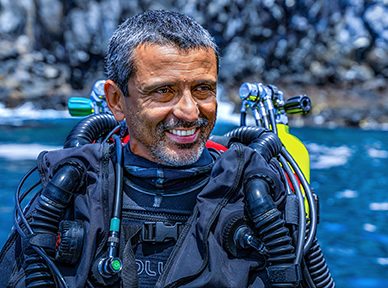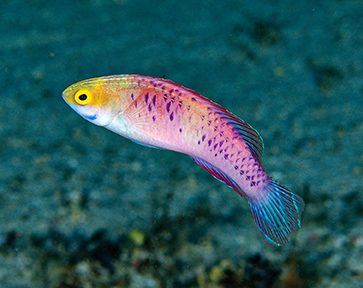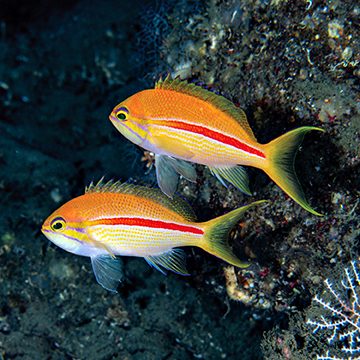LUIZ ROCHA, PH.D., TELAH MENJADI SEORANG PRIA DALAM MISI IKAN since he was a young boy exploring the waters in his small coastal hometown in Brazil. He investigated tidepools, had fish tanks when he was 5 years old, and was declared a future scientist by his third-grade teacher. It was always about the fish — and exploring the unknown. “The deeper the water, the more unknowns,” Rocha said.
When a dive instructor arrived in Rocha’s hometown in 1989, he joined the first open-water class available. He became a divemaster so he could keep diving while not being able to afford his own gear. It was an unpaid job, but he could use the gear at no cost. While Rocha said he did some deep diving in those days that he wouldn’t do now with formal training, those early deep dives were the start of the career he has today.
On some of those early dives in Brazil, he started noticing some fish that “looked a little different.” He sought answers for identification and eventually came to the U.S. in 1999 to get his doctorate at the University of Florida. The lab in which he worked had the tools he needed to look at DNA variation to determine if the fish were indeed different species.
Rocha’s objective was to study deep reefs (150 to 500 feet), but studying deep waters comes with challenges. Rocha went to several institutions where he found it difficult to be authorized or get the necessary support to do the type of diving required for his work. The dive support he needed was at the California Academy of Sciences (CAS).
Rocha currently is the curator of ichthyology at CAS, where he maintains a collection of 2.5 million fish. He said to think of the specimen collection much like a library, but “instead of books, my library has fish jars.” Each species is preserved in a jar of alcohol and has information associated with it, such as who collected it, where and when, and what kind of habitat it came from. All this information goes into an open-access database that is free to the public. The collection started in 1853 and is one of the world’s largest.
As part of his role at CAS, Rocha travels to various parts of the world to research deep reefs. On every expedition he tries to discover species never seen before to add to his collection. He has named 32 fish species to date, with 15 in his lab waiting to be formally named. “We know a lot about coral reefs,” Rocha explained. “A lot of people like to study them. But 99 percent of what we know about coral reefs comes from the top 100 feet because that is accessible using normal recreational gear. The bottom two-thirds of coral reefs are almost completely unknown — that is one of the main reasons I study them.”
Rocha is the science leader of the CAS Twilight Dive Team. The team’s divers train to dive to depths the average diver has never explored. While chasing a fish took Rocha to 503 feet, his deepest dive on record, the team prefers to max out at 500 feet. This limit is primarily because the decompression time becomes too long; they try to keep their total dive times between six and seven hours. CAS has one of the largest, most active dive teams of its kind.
Training for the Twilight Dive Team is extensive, but they never take diving to these depths lightly. There is always a dive safety officer in the field who, in addition to overseeing the dive’s safety aspects, is also usually a rebreather instructor and has the technical training to fix rebreathers in the field.
The first dive of every expedition is 30 to 40 feet, where the team executes basic exercises and simulates various scenarios to build local memory. Rocha’s experience and training allow him to do these dives without fear, but he admitted, “The 30 minutes before hopping in the water always has an air of anxiety, with everyone checking that everything is set up properly, and lots of thinking, concentration, and preparation.” Being comfortable diving to these depths is critical because Rocha is not only exploring but also working.
Rocha explained that his primary objective for his work is “to make a difference in the world in terms of conservation.” He is concerned about the fact that, for the most part, deep reefs are not protected. “Shallow reefs are more and more protected or, when not protected, are overfished. Both scenarios drive fisheries to deeper reefs. When people can’t fish on shallow reefs, they go to unprotected deep reefs.”
Rocha recognizes the role the public plays in conservation. “To protect these reefs, we need to show people the fantastic species they host,” he said. “If I don’t talk about these fish to the public, I won’t have an impact.”
Selain publikasi ilmiahnya, Rocha telah menulis berbagai artikel opini untuk New York Timesdan ia sangat senang dengan perhatian media yang diberikan kepada spesies terbaru yang ia dan timnya temukan: ikan peri terselubung mawar (Cirrhilabrus finifenmaa).
When asked to name his favorite fish, he responded that it was too hard to answer but then changed his mind and said that his current favorite is this newly found wrasse. Nongovernmental organizations in the Maldives, where Rocha’s team found the wrasse, are already using the fish to make a case to protect deeper reefs.
Untungnya, bagi kita semua yang tidak memiliki pelatihan untuk menjelajahi terumbu karang yang dalam, Rocha adalah seorang fotografer yang berbakat. Ikuti akun Instagram dan Twitter @Coralreeffish untuk melihat sekilas beberapa ikan yang ia temui saat menyelam di perairan dalam.

Luiz Rocha
Kampung halaman:
João Pessoa, Brazil
Bertahun-tahun Menyelam: 33
Tujuan Menyelam Favorit:
I have too many favorites! It depends on the category — I have different favorite places for coral reefs, wrecks, diversity, etc.
Mengapa saya menjadi Anggota DAN:
Saya telah menjadi anggota DAN sejak pertengahan tahun 1990-an karena saya sering menyelam dan membutuhkan asuransi. Penting untuk mengetahui bahwa Anda terlindungi, terutama saat bepergian.

Foto: Luiz Rocha

Foto: Luiz Rocha

Foto: Luiz Rocha
Rocha explained that his primary objective for his work is “to make a difference in the world in terms of conservation.”
© Penyelam Siaga — Q2 202